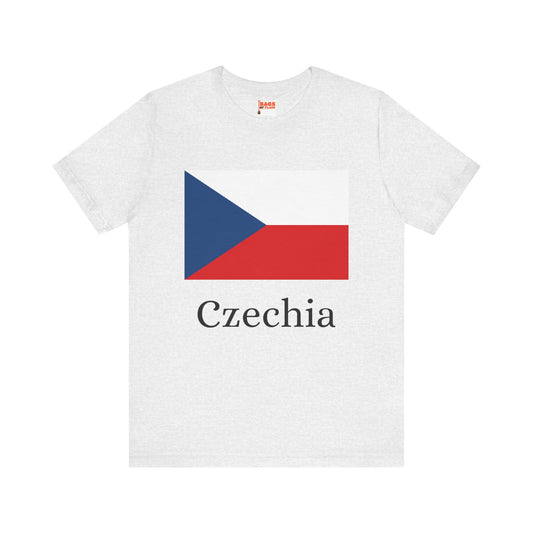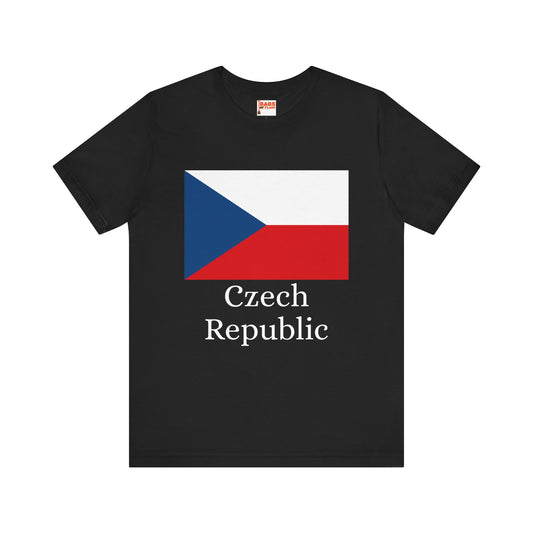-
Czech Republic Pillow
Regular price $22.65 USDRegular priceUnit price / per -
Czech Republic Leather Patch Hat
Regular price $18.85 USDRegular priceUnit price / per -
Czech Republic Flag Sweatshirt
Regular price $34.15 USDRegular priceUnit price / per -
Czechia Sweatshirt
Regular price $34.15 USDRegular priceUnit price / per -
Czech Republic Sweatshirt
Regular price $34.15 USDRegular priceUnit price / per -
Czech Republic Mug
Regular price $11.65 USDRegular priceUnit price / per -
Czechia Hoodies
Regular price $34.40 USDRegular priceUnit price / per -
Czechia T-shirts
Regular price $22.79 USDRegular priceUnit price / per -
Czech Republic Hoodies
Regular price $34.40 USDRegular priceUnit price / per -
Czech Republic T-shirts
Regular price $22.79 USDRegular priceUnit price / per -
Czech Republic Flag T-shirts
Regular price $22.79 USDRegular priceUnit price / per -
Czech Republic Flag on Hoodie
Regular price $34.40 USDRegular priceUnit price / per
Collection: Czech Republic
The Czech Republic flag symbolizes national pride and identity for the people of this Central European country. The flag of the Czech Republic, also known as the flag of Czechia, features a simple yet powerful design with deep historical and cultural significance. We will delve into the design, history, symbolism, current relevance, and fascinating facts about the Czech Republic flag.
Overview of the Czech Republic Flag

The national emblem of the Czech Republic is elegantly represented through a bicolor flag, where a white strip occupies the top half and a red one the bottom, split equally to convey balance and unity. A unique feature that distinguishes this flag from a simple bicolor design is the inclusion of a blue triangle extending from the hoist side. This geometric shape introduces a third color into the flag, deepening its visual and symbolic complexity. The flag’s proportions, set at a 2:3 ratio, ensure a harmonious display whether fluttering on a pole or hung as a banner.
This distinctive flag design represents the Czech Republic's sovereignty and bridges its historic traditions with its present-day identity. Incorporating the blue triangle is particularly noteworthy, as it adds a dynamic element to the flag's aesthetics while enriching its symbolic narrative. The blue triangle represents the Czech lands' Slavic heritage and contributes to the flag’s recognition on the global stage.
Historical Context of the Flag

Adopted on March 30, 1920, the flag of the Czech Republic became a symbol of national independence in the aftermath of World War I and the dissolution of the Austro-Hungarian Empire. This era marked the birth of Czechoslovakia, uniting Czechs and Slovaks under one national banner. The flag's design, featuring a white and red field with a blue triangle, was chosen for its distinctiveness and to avoid confusion with the Polish flag, which shares the same white and red color scheme but without the blue.
Despite Czechoslovakia's split into the Czech Republic and Slovakia in 1993, the Czech Republic retained the original flag design. This decision was controversial, as some argued that creating a new flag would better represent the Czech Republic's newfound independence. However, the historical significance and widespread recognition of the existing flag prevailed. Throughout the years, this flag has witnessed the nation's challenges and triumphs, serving as a steadfast symbol of Czech identity, sovereignty, and the enduring spirit of its people.
Symbolism Behind the Czech Republic Flag
The colors and shape of the Czech Republic flag are rich in symbolism, each element carefully chosen to reflect the nation's identity and values. The white color atop the flag symbolizes the Czech people's purity, honesty, and peaceful intentions. In contrast, the red color below represents bravery, courage, and the enduring spirit of the nation, willing to make sacrifices for freedom and independence. These two colors, drawn from Bohemia's historical coat of arms, carry centuries of history, narrating the story of a people steadfast in their pursuit of sovereignty and dignity.
The blue triangle, protruding from the hoist side, adds a deeper layer of meaning to the flag. It signifies truth, loyalty, and the Czech Republic's Slavic heritage, visually representing the country's roots in Slavic brotherhood and unity. This element ensures the flag is distinctly Czech, differentiating it from other Slavic nations while underscoring common cultural and historical bonds. The three colors form a harmonious blend, encapsulating the essence of the Czech Republic's past struggles, present achievements, and future aspirations. Through its design, the flag narrates a story of unity, resilience, and the enduring hope of the Czech people, serving as a beacon of national pride and cultural identity.
Current Relevance of the Flag
Today, the Czech Republic flag waves proudly at significant national events, such as Independence Day, and during international sports competitions, showcasing national pride and unity on the global stage. It also plays a vital role in military ceremonies and state functions, symbolizing the authority and sovereignty of the nation. The flag's visibility in these contexts underscores its continued relevance and importance as a national symbol, connecting the past with the present and future aspirations of the Czech people.
Discussions around the flag occasionally surface, particularly concerning its historical roots and representation, highlighting the ongoing engagement of the Czech population with their national symbols. Such debates reflect the dynamic nature of national identity, demonstrating that the flag remains a living symbol with the power to unite and sometimes polarize, depending on the context in which it is used or the interpretations placed upon it. Its presence in domestic and international arenas signifies the Czech Republic's steadfast position in the world, embodying its people's values, history, and aspirations.
Additional Facts About the Czech Republic Flag
In the realm of etiquette and protocol, the flag of the Czech Republic commands a high level of respect. Specific guidelines dictate its proper display, ensuring it is always presented in a manner befitting its stature. For example, when displayed alongside other flags, the Czech Republic flag must be placed in a position of honor – to the observer's left. This rule underscores the importance of national pride and the flag’s symbolic preeminence. Furthermore, the flag is flown at half-mast during national mourning or remembrance events, solemnly acknowledging grief or respect for the occasion.
The Czech Republic flag's lesser-known but captivating aspect involves its legal protection. It is one of the national symbols protected by law against misuse or desecration, reflecting the deep reverence held for the flag. Violations of this law are taken seriously, highlighting the flag’s significance beyond its fabric.
Intriguingly, there was once a myth that the blue triangle was added to the flag at the last minute to distinguish it from Poland’s. While this tale has been debunked, it adds a layer of folklore to the flag’s history, demonstrating how national symbols can capture the imagination.
Additionally, the Czech Republic flag has made its mark in space. In 1993, it was carried aboard the Space Shuttle Endeavour, symbolizing the nation’s contributions to global scientific endeavors and showcasing its pride beyond Earth's boundaries. This unique journey highlights the flag's role as a bearer of national identity and aspirations in the vast expanse of space.
























